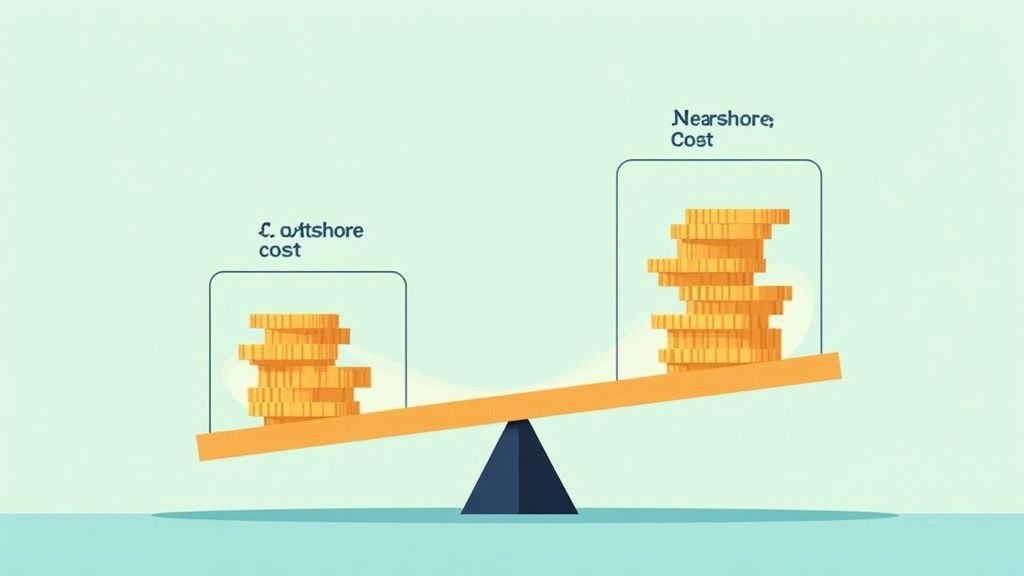
So, you need to scale your tech team. The choice is supposedly simple: nearshore for collaboration, offshore for cost. But let's be real—that's HR talk. The real decision is whether you want a team that feels like an extension of your office or a team that feels like you’ve taken on a second job as a night-shift manager.
I’ve bled money on both models. I’ve found gems and I’ve hired duds. This isn't a generic comparison; it's the guide I wish I’d had before making a few very expensive mistakes.
Let's cut the crap. You're here because hiring engineers is a nightmare. It's either absurdly expensive to hire in your city, or you're staring into the global talent abyss, wondering who you can actually trust. Turns out there’s more than one way to hire elite developers without mortgaging your office ping-pong table.
We're breaking down the two big players—nearshore and offshore—but without the corporate fluff. This is about the real trade-offs you make with your money, your time, and your sanity.
This chart gets right to the point: the constant tug-of-war between the hourly rate you brag about and the real-time collaboration you actually need.

See that? The offshore model's rock-bottom price comes at the steep cost of your team's agility. Every hour of time difference is a crack in your workflow.
Jargon is exhausting. Let's cut through the noise. Here’s a quick, no-fluff comparison of what actually matters for your day-to-day operations and, more importantly, your bottom line.
This table is the cheat sheet. It’s what each model really means for your team, stripped of the marketing nonsense.
| Factor | Nearshore (Your Neighbor) | Offshore (Your Pen Pal) |
|---|---|---|
| Time Zone Overlap | High (1-3 hours difference). This means you can actually talk to them. | Low (8-12+ hours difference). Your workday is their midnight. Good luck. |
| Communication | Fluid, agile, spontaneous. Feels like they're in the next room. | Mostly by email. Get ready for 24-hour feedback loops on simple questions. |
| Cultural Alignment | High. Shared business etiquette means you get to the point faster. | A total crapshoot. Different work styles can bring productivity to a grinding halt. |
| Cost | Cheaper than US rates, but you're paying for quality and alignment. | The cheapest on paper. The most expensive in terms of your time and sanity. |
This isn't just about a line item on a budget. It's about how you want your team to work. Do you want a cohesive unit that solves problems together, or a distributed group playing a slow game of email tag?

When founders go global, they make the same rookie mistake: they fixate on the hourly rate. It’s a trap.
Seeing a developer in Asia for $35 an hour next to a nearshore developer in Latin America for $60 an hour feels like a no-brainer. But that math is dangerously simple—and completely wrong. The sticker price is a lie.
It’s the tip of an iceberg made of hidden costs, lost productivity, and soul-crushing management headaches. To understand the real financial hit, you need to think in terms of Total Cost of Engagement. This is where the "cheaper" option almost always bites you back.
Let's pull apart that tempting $35/hour offshore deal. What does that rate conveniently forget to mention?
That $35/hour developer isn’t a bargain; they're a constant drain on your local team's time. Hope you enjoy your new part-time job managing a team on the other side of the planet.
The real comparison isn't about hourly rates. It’s about the total investment required to get a feature from idea to production. When you factor in the management overhead and rework, the offshore "deal" quickly evaporates.
Now, let's look at that nearshore developer at $60/hour. Yes, the number is higher. But what are you actually buying for that extra $25?
You're buying alignment. You're buying a developer who is awake when you are. You're buying the ability to jump on a quick call and solve a problem right now. You’re paying for speed, clarity, and less friction.
The real value:
This isn't just my opinion. The market is waking up. One study found that 42% of companies now prioritize access to talent over pure cost reduction (34%) when going nearshore. Founders are finally realizing that value beats a low hourly rate.
To get a real handle on the costs, you first need to understand the overall cost of app development. That hourly rate is just one small, misleading piece of the puzzle. The "cheaper" offshore developer often costs you far more in delays, rework, and your most valuable resource—your own damn time.
Let's talk about the "asynchronous curse." It’s the dirty secret of offshore outsourcing that sounds efficient on paper but plays out like a slow-motion car crash. You think you’re a genius for hiring someone who codes while you sleep. What you’ve actually done is sign up to be the permanent night-shift manager.
The offshore model is brilliant until your most critical bug fix gets stuck in a 24-hour feedback loop. A simple question—"Hey, which API endpoint should this hit?"—becomes a full day's delay. You send the question at 5 PM. They wake up, answer it eight hours later, and by the time you see it, they’re gone.
Congratulations. You just turned a five-minute clarification into a full-day blocker. Now multiply that by every small question, every single day. That’s the brutal reality of working across a massive time gap.
Remember agile? That thing you said you do? Kiss it goodbye. Agile is built on rapid, real-time communication. Daily stand-ups, pair programming, quick huddles—that’s the lifeblood of a productive team.
When your team is separated by a 12-hour gulf, those rituals become a joke.
You’re not running an agile team anymore. You're running a postal service where developers mail each other questions and wait a day for the reply. It’s slow, demoralizing, and the exact opposite of innovative.
Now, contrast that nightmare with nearshore. We’re talking a one to three-hour time difference. This isn't a minor convenience; it’s a game-changer that dictates your entire operational tempo. It’s what separates an integrated team from a disconnected resource.
What does that overlap actually buy you?
It buys you a normal workday. It means your daily stand-up happens at a reasonable hour, fostering actual discussion. It means when a developer has a question, they get an answer now, not tomorrow.
This ability to collaborate in real-time is the secret weapon. For a deeper dive, our guide on the role of time zones in remote work breaks down how small overlaps have a massive impact. A nearshore setup transforms your remote talent from a ticket-taking service into a true extension of your in-house crew.
When you weigh nearshore vs. offshore, don’t just look at the clock. Offshore means delays and friction. Nearshore means alignment and speed. The choice is about whether you want a team that works with you, not just for you.

This is where most outsourcing efforts quietly die. It doesn't happen in the budget meeting. It happens in the day-to-day friction of misaligned expectations and cultural wires getting crossed. This is the stuff that never shows up on an invoice but costs you launches, features, and your sanity.
Most founders think communication is just about language. "Oh, they speak great English!" is the classic mistake you make right before learning a very expensive lesson. Fluency is just the entry fee. The real difference is cultural context and communication style.
It’s the difference between a developer who just completes tickets and one who feels comfortable enough to challenge your bad ideas.
In many offshore cultures, there's a strong deference to authority. Sounds great, right? Wrong. It means your team will say "yes" to everything—even when they know a timeline is insane or a technical approach is a dead end. They're being polite, but that politeness is steering your project straight off a cliff.
You don't want order-takers. You need problem-solvers who will push back, ask "why," and contribute to the strategy.
A great engineering partner isn’t afraid to tell you your idea is bad. An offshore team might agree to build it anyway, but a nearshore partner, operating with a similar business mindset, will save you from your own worst impulses. Toot, toot! That’s the sound of us saving your roadmap.
This isn’t about one culture being "better." It's about finding a communication style that fits the fast-paced, direct feedback loop required to build great products.
Nearshore partnerships, especially with teams in Latin America, thrive because of this cultural proximity. There’s a shared understanding of Western business norms that cuts out a huge amount of guesswork.
What does that look like in the real world?
This alignment isn't an accident. Understanding how cultural fit is the key to successful remote hiring in LATAM can be the single most important factor in whether your global team sinks or swims. You're not just hiring hands to write code; you're integrating a new brain into your company's intelligence.
An offshore model feels like you’re managing a vendor. A nearshore model feels like you’re just expanding your team. That alone is worth its weight in reclaimed weekends.
Let’s talk quality. It’s the one thing you can't compromise on, but it's often the first thing to vanish when you hire the wrong remote team. How do you ensure you’re getting A-players and not just someone who looked good on a resume?
The answer reveals one of the biggest divides between nearshore and offshore. It’s not just about who can write code; it’s about who can think.
Too many founders get mesmerized by low offshore rates and forget to ask the most important question: who is actually vetting these people?
Hire through a traditional offshore agency, and you’re trusting a process you have zero visibility into. You get a few resumes and a sales pitch about their "rigorous screening." Then you’re on your own. Hope you enjoy spending your afternoons fact-checking resumes and running technical interviews—because that’s now your full-time job.
This model treats developers like interchangeable parts. The agency’s job is to fill a seat, not find someone who will elevate your product. They get paid, you get a warm body, and the real quality control is left entirely to you.
You’re not just outsourcing development; you’re insourcing the entire burden of technical vetting, cultural screening, and quality management. It’s a hidden cost that turns a cheap hourly rate into a very expensive headache.
This approach is broken. It assumes building software is a simple, transactional task. It’s not. It’s a team sport that requires deep collaboration and strategic thinking.
This is where modern nearshore models change the game. The best partners don’t just forward you a list of candidates. They act as an extension of your own hiring team, embedding themselves in your process to understand not just the technical requirements, but the strategic ones, too.
They've moved far beyond just supplying coders. Today’s top nearshore firms are full-cycle engineering collaborators. This shift is crucial for complex tech like generative AI and machine learning. You can explore more insights about modern nearshore partnerships to see how deep this trend runs.
So what does a real partnership look like? It’s a multi-layered approach designed to find thinkers, not just doers.
Ultimately, the offshore model sells you a resource. The nearshore model connects you with a partner. One is focused on fulfilling a contract; the other is focused on helping you build a better company. You can guess which one delivers higher quality.

Alright, enough theory. Let’s get down to brass tacks. When do you actually pull the trigger on each? This isn’t about a one-size-fits-all solution. It's about being brutally honest about your project, your team's bandwidth, and how much you enjoy working at 10 PM.
Look, offshore isn’t evil. It’s a specialized tool for a specific job. It can be a smart move, but only if you go in with your eyes wide open.
Go offshore when:
If your project checks all these boxes, great. But if you’re building your core product and need to stay agile, forcing it into an offshore model is like trying to win a Formula 1 race with a bulldozer. It’s slow, clunky, and you'll probably crash.
For pretty much everything else? You go nearshore. This is a strategic decision to prioritize speed, collaboration, and quality over a misleadingly low hourly rate. The market agrees. The nearshore outsourcing market is projected to hit nearly $4 billion by 2034, and 63% of financial companies now use it to boost quality.
Choose nearshore when:
The choice is this: Offshore is for executing a known, fixed plan at the lowest cost. Nearshore is for building, iterating, and innovating with a team that feels like your own. Choose wisely.
You've seen the data, but a few questions are probably still nagging you. Let's get right to them. No BS, just founder-to-founder answers.
This is a big one, and it should be. Short answer? Your IP is far more secure with a nearshore partner. Why? Legal alignment. Data protection laws in Latin American countries often mirror those in the U.S. and Canada, creating an enforceable environment.
Offshore can be the Wild West. Trying to enforce an NDA across vastly different legal systems is a nightmare. It's not just about trusting your team; it's about having real legal recourse if things go south. With nearshore, you’re on much safer ground.
Frankly, if you’re building something truly proprietary, betting your company’s future on the shaky legal ground of a distant offshore location is a risk I wouldn't take. The savings aren't worth the existential threat.
Don't dive in with a massive, multi-year contract. That’s a rookie move. Start with a well-defined pilot project. The key is to find a true partner, not a body shop that just rents out developers.
Here’s a simple framework:
This lets you test the workflow, talent, and relationship in a low-risk way. If they knock it out of the park, scaling up is easy. If they don’t, you walk away with minimal damage. With an offshore model, even a small pilot can feel like an uphill battle from day one.
